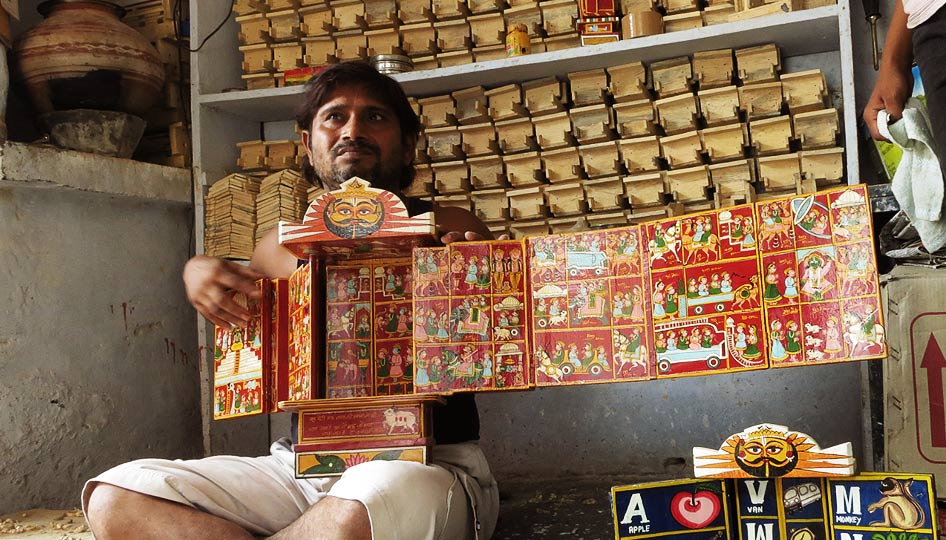It is imperative that knowledge must be shared among individuals as well as across generations. This includes not just knowledge of scientific advancements and technological innovations, but also those that are imbibed in our cultures and traditions. Countries are separated from one another geographically and politically; they are also diverse from one another in their cultures. Thus, it becomes important that an effective medium is adopted to understand and appreciate these differences across the globe through shared knowledge.
India is a one such land of cultural diversities and a potpourri of varied traditions. So it is natural that every state in the country has its unique way of narrating stories. Here is an overview of one such tradition – the Kaavads of Rajasthan.
THE KAAVADS OF RAJASTHAN
‘Kaavad Banchana’ is a traditional form of oral storytelling which dates back to about 400 years. Kaavad means ‘half a door’ or ‘panel of a door’ and Banchana means to show/read and narrate. This form of storytelling is still kept alive to some extent in Rajasthan and is considered to be one of the most unique and colorful forms.
Kaavads are portable wooden boxes, intricately carved and colourfully decorated with bright paints. The panels are hinged to one another and lead inwards to the innermost chambers of the box that resemble the holy sanctum of the divine. Every panel is painted with gods, goddesses, heroes of the regional folklores, patron saints and characters from the ancient mythology and Puranic stories. Each panel depicts a plot or a part of the story series which is narrated by the storyteller using a peacock feather as a pointer.

Source: Gaatha
THE TRINITY UNION OF KAAVADS
A community of artisans from Mewar called ‘Suthars’ or ‘Basayatis’, are the carpenters responsible for creating these finely crafted Kaavads. The Suthars employ handmade tools to carve out the boxes and then decorate those using vivid coloured paints and colourful stones. The art of Kaavad making holds great importance to the community and they consider it equally holier than any temple.
The ‘Kaavadiya Bhats’ are the peripatetic narrators of this repertoire of stories, who carry with them these Kaavads to the houses of patrons. The community of storytellers is originally from Marwar but live around Jodhpur, Nagaur and Kishangarh districts of Rajasthan. The term ‘Bhat’ is specifically used for this community of storytellers who are distinguished from the water-bearer ‘Kaavadiyas’.
The narration normally begins with a prayer dedicated to the gods and goddesses of the patrons as a means of seeking the sanction to perform. The narrative is rhythmic and the narrator progresses with the story, dexterously manoeuvring the panels consisting of specific stories, all the way till he reaches the innermost chamber of the box.
This holy trinity of Kaavad Banchana is incomplete without the listeners. The Kaavadiya Bhats visit the houses of the patrons also known as the ‘Jajman’ with their Kaavads and narrate stories to them. The Kaavadiya Bhats, who are chiefly the patrons of the Suthars, are skillful in the narration of the stories that can be tailor-made to suit their patron families and the context. This involves praising the patron gods or goddesses and saints, the genealogy of the family and the epic stories associated with their heritage. The concept behind this is to bring the temple to the devotees, rather than they going to temples.
The giver (storyteller) and the receiver (patron) both consider the Kaavad as a holy shrine and the rituals of storytelling and offering the donation contribute to the sanctity of this art. There is a synergy that exists between the creator of the Kaavads, the narrator of the stories and the patron listener, and perhaps this has contributed to the legacy of the Kaavads.
The art of Kaavad storytelling not only plays an important part in shaping the ancient culture inherent in the soil of Rajasthan but is also instrumental in passing the knowledge of traditional values across generations.
EPILOGUE
Stories do not speak for themselves. They need a narrator who can share them with a listener filled with a sense of purpose to pass on the same. The art of storytelling through Kaavads, like many other art forms, is a rich means of sharing the ideas imbibed in the amalgamation of cultures and traditions.
With the country progressing towards rapid digitalisation, the present generation is mainly inclined towards the modern means of entertainment and communication. It is very much essential that this rare and unique form of storytelling must be kept alive to make the future generations familiar with the essence of the bygone times of our rich culture and preserve it for an eternity.





Hi…I loved the article on Kaavad banchana. I wanted to enquire if anyone has any contact number of the authentic Kaavad story tellers, so that I could invite them to Delhi to share their stories with Delhi audience?